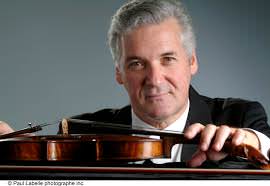Zukerman ChamberPlayers at Ravinia
Dvořák: Piano Trio No. 4, Op. 90 (“Dumky”)![]()
Beethoven: Piano Trio in B-flat Major, Op. 97 (“Archduke”)
At Ravinia Festival, Highland Park
Along with Itzhak Perlman, Pinchas Zukerman is perhaps the most prominent contemporary exponent of the traditional “Russian school” of violin-playing associated with past greats such as David Oistrakh and characterized by an exceptionally rich, warm tone and sweetly expressive, if only moderately incisive, phrasing. As one who laments the comparative neglect into which this style has fallen in recent years, I relished the chance to hear Zukerman at Ravinia, joined by colleagues previously unknown to me but clearly trained in a similar tradition (cellist Amanda Forsythe and pianist Angela Cheng), especially given the program’s pleasing repertoire and the interpretative impact to which the virtuosity and musical warmth on display was joined.

Dvořák’s “Dumky” Trio, which opened the concert, is not the traditional three- or four-movement work associated with the piano-trio form, but rather a sort of collection of seven freely structured musical vignettes, achieving the effect of a song-cycle for chamber ensemble. And what “songs” these are, with some of the loveliest melodies imaginable, wistful and effusive by turns and often glorious in their sweep. Zukerman and company gave a glowing rendition, marked by sweetness and depth of tone and breadth of phrase. Some of the fast violin runs could perhaps have been more cleanly articulated, but otherwise Mr. Zukerman’s playing was at its best, strikingly secure and pure in the upper register, powerful and fluid throughout. I was also impressed by the warm and grand yet un-percussive piano sound produced by Ms. Cheng. Yet in some ways – and notwithstanding the presence of the justly renowned Zukerman – it was cellist Amanda Forsythe whose playing impressed me the most, with powerfully sustained long singing lines and a sweet yet firm tone that never turned gruff, as can happen on the sometimes unwieldy cello even for fine musicians. In its color and intensity this was chamber musicianship of another era, yet the passion and personality were never achieved at the expense of ensemble: indeed, the unity of attack and phrasing among the members of the trio was exceptional. This performance was a reminder that such values do not require a lapse into the small-scaled, restrained playing one hears perhaps too often today.
Thankfully, all the same virtues remained on display in the performance of Beethoven’s “Archduke” Trio that followed. While this piece may lack the more striking emotional qualities of some of the composer’s other chamber pieces – the fire of the “Kreuzer” Sonata for violin and piano, or the tragedy of the String Quartet Op. 131, and indeed the sheer sublimity of many of his quartets – it is in many respects a masterful work, bringing many more subtle pleasures of its own. A good example is the development section at the center of the first movement, which hardly builds to an overwhelming climax, yet is immensely engaging in the unpredictable and imaginative way in which it reintroduces fragments of themes from the movement’s exposition. As in the Dvořák, the performance was both technically impeccable and thoroughly enlivening, as was that of the charming march by Fritz Kreisler offered as an encore – a fitting conclusion to a nearly ideal evening of chamber music.
Highly recommended.
Samuel Wigutow
